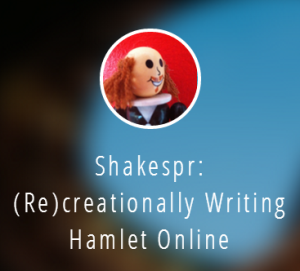Overview:
My project argues, through a case study on Hamlet, that tumblr users in the Shakespeare fandom have constructed their own Shakespeare that reflects both the demystification of the exception Author and the deconstruction of a monolithic, culture-controlling Academy. While tumblr users genuinely seem to enjoy Shakespeare’s work and value the texts immensely, they do not bring a sense of reverence to Shakespeare as typically presented in high school and college classrooms. They engage in the queer readings some academics pursue but that never reach a first-time reader of Hamlet. They place Hamlet next to Ke$ha without batting an eye. And they turn Hamlet‘s narrative into a series of emojiis. (Among other things). Often through collaborative writing , tumblr re-presents, remixes, and remediates Shakespeare. Along the way, the site recreates Shakespeare’s body of work as fun and flexible, and Shakespeare becomes Shakespr.
Process:
I suppose I can say that I started this essay (without really knowing it) before I started this course. I have been on tumblr for several years now, and I have been pursuing Renaissance literature (particularly Shakespeare) for about the same amount of time. So, before the course began, I had already had on my blog several posts from other users about Shakespeare. Posts I found fascinating to view.
When I began this course, I knew early on that I wanted to work with tumblr. As I’ll talk more about below, I think that tumblr’s interface – though it might take a bit getting used to – allows for variation in digital composition.
In looking at the Shakespeare posts, I first continued my collection work. I followed as many Shakespeare blogs I could find, reblogged a bunch of posts about Hamlet, used my tumblr at first to curate.
I then went through these posts to categorize the different modes users employed in discussing Shakespeare. It was at this point that I made the divisions: re-present, remix, and remediate. I organized the blog by dramatic vocabulary: preface, dramatis personae, three acts, an epilogue, and source materials. I then got a lot of excellent feedback from my group on how to guide my audience across these divisions.
Affordances:
For me, the main appeal of tumblr is the way in which posts are divided. A post can be text, photo, video, a chat, a link, a quotation, or any variation/combination thereof. Tumblr can be extremely visually appealing as it integrates all of these sources.
But, I would say even more than that, tumblr is immediately public in a way other blogging sites are not. If I tag a post “Shakespeare” the post immediately moves into the website tags, where anyone who is scrolling through or tracking the tag can see it. Users on tumblr also, then, read differently. They usually read in their dashboard – looking at tracked tags or what the people they follow reblog. Generally speaking, they do not encounter a blog by going to the blog home page, but by seeing one post by that user and then looking for more. The interaction this enables made me view my writing as much more public than I otherwise would (especially when I was writing my commentary directly on the posts of other users).
Constraints:
Tumblr is not designed for a linear essay. One of the constraints I dealt with was how to link clearly and easily across all of my posts so that users both familiar and unfamiliar with the site could navigate my essay. The other main constraint is in the writing process on tumblr; when things are posted, they are (generally) complete posts. So I did have to respond to one confused (and slightly aggressive) anonymous message about how my blog was working.
Overall, I have absolutely enjoyed this writing process and project, and might have already started a more long-term blog about being a graduate student more broadly…(plug).
I look forward to talking about my work and hearing about everyone else’s!

